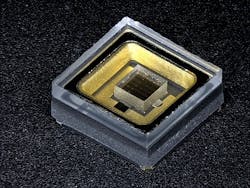Applications ranging from curing to disinfection and sterilization will benefit from new UV LEDs in the 265–300-nm band.
Nikkiso America has announced the general availability of 50-mW deep-ultraviolet (UV) LEDs that the company said have operating lifetimes in excess of 10,000 hours. The evolution of UV-LED technology at shorter wavelengths holds great potential for applications ranging from industrial curing to water sterilization. UV-LED manufacturers, however, have struggled to deliver high-power, long-life, and cost-effective LEDs in the deep-UV range, although Nikkiso, and competitors such as Crystal IS, Sensor Electronic Technology (SETi), and RayVio are all making technological progress in the UV LED space.
Interested in more articles & announcements on UV LEDs in applications?
The latest Nikkiso UV LEDs address the issue of delivering useful levels of radiometric power in a small packaged LED. The company said the 50-mW output at 350-mA of drive current is 1.7 times the power of its prior generation products. That performance level combined with the long-life expectation is seen as key to commercial success in UV LEDs.
“UV LED technology is advancing rapidly, with extraordinary progress reported annually in optical output power, efficiency, and cost,” said Dennis Martin, president and CEO of Nikkiso America. “Whether the application involves curing, medical, germicidal, or analytical instrumentation, deep-UV LED technology offers compelling advantages over lamp-based solutions and further enables new applications.”
The company is shipping the new LEDs in a surface-mount device (SMD) package at a wavelength of 285 nm. As we covered in an article about presentations made at Strategies in Light, the biggest challenges have come for LED makers targeting the UV-C band from 100–280 nm. Nikkiso said it will soon add product releases at the 265-nm band moving into the UV-C range.
Nikkiso is unique in that it has a short heritage as an LED maker, but rather wants to utilize UV-C LEDs in some of its own industrial products including water pumps that might integrate UV sterilization technology. The company announced its intentions in the UV-LED space in early 2015 and has a technology base developed by Professors Isamu Akasaki (Meijo University, Nagoya, Japan and Nagoya University, Japan) and Hiroshi Amano (Nagoya University, Japan), two of the scientists credited with developing the blue LED.
Other UV news
In other recent UV-LED news, SETi has announced a product with performance levels similar to the Nikkiso announcement. The company said it is offering an SMD LED at 275 nm with 30 mW of power at 350 mA. At the end of 2015, SETi said the Model SS35DF227513 LEDs had entered high-volume manufacturing.
SETi also announced the acquisition of UV-LED manufacturer Nitek late last year. That move was said to increase SETi’s deep-UV epitaxial capacity, thereby speeding the uptake of UV-LED technology in applications such as sterilization.
In 2015, we reported that SETi was working as a partner with Seoul Viosys in commercializing UV LEDs. And SETi has become the exclusive distributor for Seoul Viosys UV-A LEDs in North America.
The potential of UV LEDs has also caught the eye of the judges in the LEDs Magazine annual Sapphire Awards program. Indeed, the Crystal IS Optan UVC LEDs have been named a finalist in the packaged LEDs and OLED sources category.






